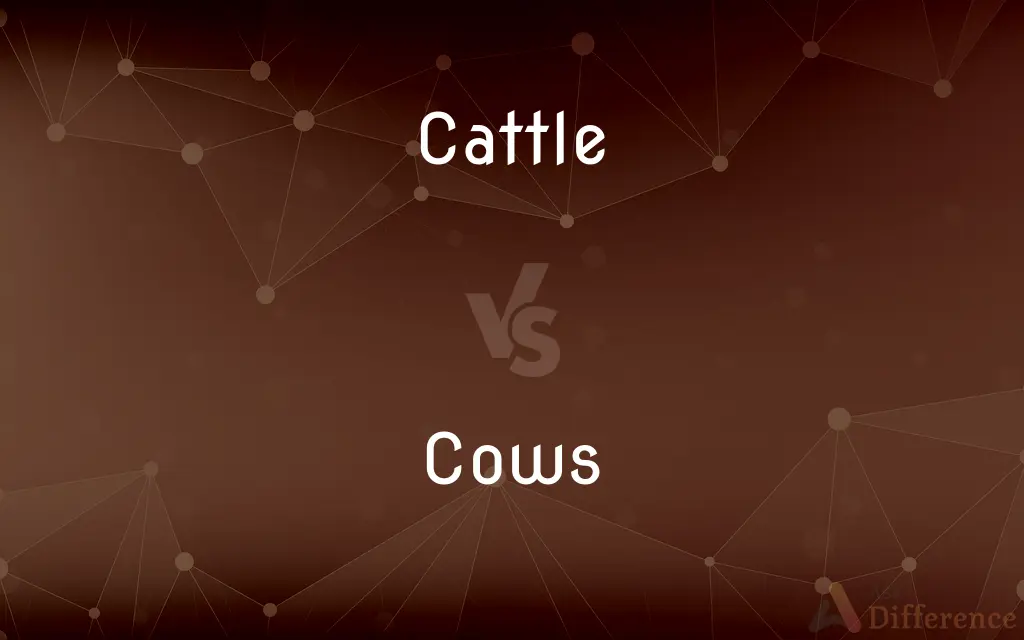Cattle vs. Cows — What's the Difference?
By Tayyaba Rehman & Maham Liaqat — Updated on April 3, 2024
Cattle refer to a group of bovine animals, while cows specifically denote female bovines that have birthed a calf.

Difference Between Cattle and Cows
Table of Contents
ADVERTISEMENT
Key Differences
Cattle is a term used to describe a group of bovine animals that includes cows, bulls, and calves, irrespective of gender or age. It is a general classification that encompasses the entire species commonly raised for meat, milk, and labor. On the other hand, cows are elders female cattle that have given birth to at least one or more calves. This distinction is significant in agricultural and dairy contexts, where the reproductive status of a bovine plays a critical role in its classification.
While cattle can be found in various environments worldwide, adapted to different climates and purposes, cows specifically play a crucial role in the dairy industry. The productivity of cows, in terms of milk production, is closely monitored in farming operations. In contrast, cattle, as a broader category, are raised for a wider range of products, including beef, leather, and even for work, as in the case of oxen.
In terms of terminology, "cattle" is a non-specific term and does not refer to the animal's gender. It's used more in an economic and statistical context when referring to the number of bovine animals in a certain area or under management. Cows, however, are often discussed in terms of their ability to produce milk or rear calves, highlighting their role in breeding and dairy production.
The management practices for cattle vary widely, from extensive ranching to intensive dairy farming, depending on the purpose they serve – be it meat, milk, or labor. Cows require specific care, especially when lactating, including specialized diets and health management to maintain high milk yields. This contrasts with the broader category of cattle, where management practices may not be as specialized unless the focus is on dairy production.
Understanding the difference between cattle and cows is essential for proper animal husbandry practices. While all cows are cattle, not all cattle are cows. This distinction helps farmers and ranchers in planning breeding, milk production, and meat production strategies effectively.
ADVERTISEMENT
Comparison Chart
Definition
Group of bovine animals
Female bovines that have birthed a calf
Includes
Bulls, cows, calves
Specifically females
Purpose
Meat, milk, labor
Primarily milk production
Care
General, varies by use
Specialized, especially when lactating
Importance
Economic and agricultural
Reproductive and dairy production
Compare with Definitions
Cattle
Domesticated bovine animals as a group.
The farmer has a large herd of cattle.
Cows
Primary source of milk in dairy farming.
High-producing cows are valuable in the dairy industry.
Cattle
Includes both genders and all ages.
The cattle on the farm are a mix of cows, bulls, and calves.
Cows
Require specialized care when lactating.
Lactating cows receive a nutritionally rich diet.
Cattle
Raised in various environments.
Cattle adapt well to different climates.
Cows
Adult female cattle that have had a calf.
The cows are milked twice a day.
Cattle
Subject to agricultural management.
The health of the cattle is monitored closely.
Cows
Involved in reproductive processes.
The farm focuses on breeding cows for improved milk yield.
Cattle
Used for meat, milk, or labor.
Cattle ranching is a significant industry.
Cows
Can be of different breeds for milk production.
Jersey cows are known for their high-quality milk.
Cattle
Cattle, or cows (female) and bulls (male), are large domesticated cloven-hooved herbivores. They are a prominent modern member of the subfamily Bovinae, are the most widespread species of the genus Bos, and are most commonly classified collectively as Bos taurus.
Cows
The mature female of cattle of the genus Bos.
Cattle
Domesticated bovine animals (cows, bulls, steers etc).
Do you want to raise cattle?
Cows
The mature female of certain other large animals, such as elephants, moose, or whales.
Cattle
Certain other livestock, such as sheep, pigs or horses.
Cattle
People who resemble domesticated bovine animals in behavior or destiny.
Cattle
Chattel
Goods and cattle
Cattle
Used in restricted contexts to refer to the meat derived from cattle.
Cattle
Quadrupeds of the Bovine family; sometimes, also, including all domestic quadrupeds, as sheep, goats, horses, mules, asses, and swine.
Common Curiosities
Why are cows important in the dairy industry?
Cows are the primary source of milk production, making them crucial for dairy farming.
What is the primary difference between cattle and cows?
Cattle is a general term for all bovine animals, while cows specifically refer to adult female bovines that have given birth.
Do all farmers raise cattle for the same purpose?
No, farmers may raise cattle for meat, milk, or even as work animals, depending on the specific needs and goals of the farm.
Can the term cattle refer to both male and female bovines?
Yes, cattle encompass both male and female bovines of all ages.
What legal considerations are there for raising cattle?
Laws regarding animal welfare, environmental impact, and food safety can all apply to raising cattle.
Is there a specific breed that qualifies as cattle?
No, the term cattle refers to all breeds of bovine animals.
Are bulls considered cattle?
Yes, bulls are male bovine animals and fall under the general category of cattle.
What is the role of calves in cattle farming?
Calves are young bovine animals, important for the continuation of the herd and, in dairy farming, the future production of milk.
Can cattle be raised in any climate?
While cattle are adaptable to various climates, specific breeds may thrive better in certain environments.
How are cattle raised differently from cows?
Cattle as a category can be raised for various purposes, including meat and labor, while cows receive specialized care for milk production.
How do dietary needs differ between cattle and cows?
Cows, especially when lactating, may have more specific dietary needs to support milk production.
Why is the term cattle used in economic contexts?
It provides a broad classification useful for statistics and management in agriculture and economics.
How does the global demand for dairy products affect cows?
It influences breeding, care, and management practices to optimize milk production and efficiency.
How do farmers differentiate between different types of cattle?
Farmers use terms like cows, bulls, and calves to specify gender and reproductive status within the broader category of cattle.
What makes a cow different from a heifer?
A heifer is a female bovine that has not yet had a calf, whereas a cow has.
Share Your Discovery

Previous Comparison
Yup vs. Yep
Next Comparison
Announce vs. DenounceAuthor Spotlight
Written by
Tayyaba RehmanTayyaba Rehman is a distinguished writer, currently serving as a primary contributor to askdifference.com. As a researcher in semantics and etymology, Tayyaba's passion for the complexity of languages and their distinctions has found a perfect home on the platform. Tayyaba delves into the intricacies of language, distinguishing between commonly confused words and phrases, thereby providing clarity for readers worldwide.
Co-written by
Maham Liaqat













































